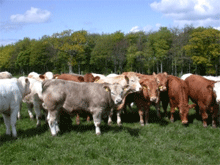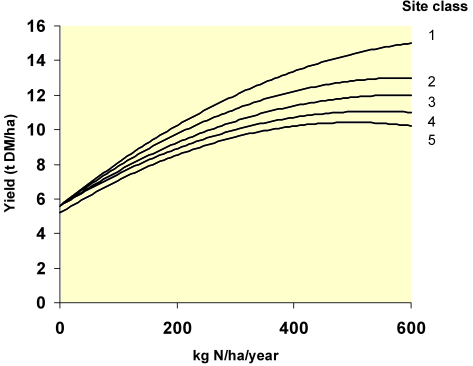



Implications for Reducing Chemical Fertilizer Inputs in Beef Production
Lynne Dawson, Agri-Food and Biosciences Institute (AFBI) Hillsborough examines the effects of zero Nitrogen (N)fertilizer input on grass growth and animal performance.
Research undertaken at the Agri-Food and Biosciences Institute (AFBI), Hillsborough) (Table 1) has demonstrated that, relative to grass swards receiving 200 kg N per hectare, grass swards receiving zero nitrogen:
- Produced 23 per cent less herbage
- Sustained 25 per cent lower total live weight gain per hectare
|
Table 1. Effect of nitrogen application (kg per ha) on herbage production and performance of growing steer calves (initial live weight 170 kg)
|
|||
| Level of Nitrogen application Zero kg per ha |
Level of Nitrogen application 200 kg per ha |
Level of Nitrogen application Zero vs 200 kg per ha |
|
|---|---|---|---|
| Herbage availability (kg per ha)‡ | 963 | 1250 | -23 per cent |
| Total gain per ha (kg) | 940 | 1260 | -25 per cent |
| ‡ herbage available above 3-4 cm. | |||

However, it is important to recognise that the magnitude of the reduction in herbage production in response to decreasing N fertilizer will vary according to ‘site class’ which is determined by soil texture and summer rainfall (Figure 1). In addition, while Figure 1 indicates that with zero N input, grass yield will be just over 5 t DM per ha this assumes that the soil has a medium N status and was previously in permanent grassland receiving 100 to 250 kg N per ha. It is important to highlight that, with successive years of zero N input, N reserves in the soil will become depleted which could seriously diminish grass growth.
Figure 1. Yield and response of grass cut six times at 4 weekly intervals (simulated grazing) to fertilizer nitrogen according to site class assuming a medium soil N status.

Effect of zero N input on grass quality
Reducing N fertilizer input has been shown to increase herbage dry matter and water soluble carbohydrate concentration and decrease crude protein concentration while having a minimal effect on digestibility (Table 2). Animal performance may be detrimentally affected if the crude protein content of grass falls to very low levels (<140 g per kg DM) due to the shortage of degradable protein in the rumen, which may limit microbial activity and reduce intake. This could have implications for maintaining the performance of young growing cattle or finishing cattle on grass-based swards.
|
Table 2. Effect of reduced N input on grass quality
|
|||
| Fertilizer N input 0 kg N per ha |
Fertilizer N input 140 kg N per ha |
||
|---|---|---|---|
| Dry matter (g per kg fresh) | 157 | 124 | |
| Crude protein (g per kg DM) | 198 | 295 | |
| Water soluble carbohydrate (g per kg DM) | 98 | 61 | |
| Digestibility (g per kg DM) | 741 | 753 | |
Alternatives to chemical nitrogen fertilizer
(i) Grass/clover swards
Research undertaken at AFBI, Hillsborough has compared the stock carrying capacities of pure grass swards receiving high inputs of fertilizer nitrogen and grass/white clover swards with a low input of nitrogen under continuous grazing management. The results from this research demonstrate that a well managed grass/clover sward receiving zero nitrogen fertilizer can have the same stock carrying capacity and produce the same live weight or carcass gain per hectare as a grass sward fertilized with 150 kg of nitrogen per hectare representing a saving of £137 per ha at a fertilizer price of £250 per tonne for 27.5 per cent nitrogen. Alternatively a grass/clover sward fertilized with 50 kg nitrogen per hectare can sustain a similar output to that from a grass sward fertilized with 200 kg nitrogen per hectare or over 80 per cent of that of a pure grass sward receiving 350 kg of nitrogen per hectare.
(ii) Slurry
While slurry offers the potential to reduce costs associated with chemical fertilizers, intensive grazing and/or silage cutting routines offer little opportunity for slurry application, with most farmers identifying difficulty in utilising slurry nutrients during the growing season. This problem has been addressed to some extent by recent advances in slurry application techniques (trailing shoe and band spreading methods) which allow slurry to be applied with greater efficiency to actively growing crops. Research at AFBI, Hillsborough demonstrated that, compared to splash plate spreading, band spreading and trailing shoe methods increased grass yield by 18 and 26 per cent, returned the equivalent of an additional 32 and 44 kg per ha chemical fertilizer N and improved the efficiency of total N application by 12 and 26 per cent respectively. In economic terms, the value of nitrogen gained by applying slurry by band-spreading or trailing shoe is worth £29 per ha or £40 per ha more respectively than if the same slurry was applied with a splash plate.
(iii) Alternative forages and utilisation of slurry
Research at AFBI Hillsborough has investigated the potential of slurry nutrients alone to support the growth of a range of perennial forages including red clover, ryegrass/white clover mixture, low input grass mixture (containing perennial ryegrass, Timothy, Meadow Fescue and Cocksfoot), diploid perennial ryegrass, tetraploid perennial ryegrass, hybrid ryegrass and Italian ryegrass. All forages have been grown using slurry as the only nutrient input with application rates of zero, 34 m3 per ha, 66 m3 per ha and 95 m3 per ha applied by trailing shoe during the growing season. Each of these application rates supplied nitrogen at zero, 128 kg per ha, 249 kg per ha and 358 kg per ha respectively. Swards containing clover (ryegrass/white clover and red clover) produced high yields at all levels of slurry application, with particularly high yields with the zero slurry application treatment (Table 4). In the absence of legumes (Italian ryegrass, low input grass mixture, diploid perennial ryegrass, hybrid ryegrass and tetraploid perennial ryegrass) yield of all forage crops increased with increased slurry application level up to 66 m3 per ha. Increased slurry application above 66m3/ha produced no further increase in DM yield. Overall the study demonstrated that high DM yields (up to 16 t DM per ha with Italian ryegrass) can be achieved using slurry nutrients alone. This represents a saving of £226 per ha in chemical fertilizer costs when applied at a rate of 66 m3 per ha.
|
Table 3. Effect of method of slurry applications on grass yield, fertilizer equivalent for DM yield and efficiency of total N application.
|
|||
| Method of application |
Grass yield (t DM per ha) |
Fertilizer equivalent for DM yield (kg N per ha) |
Fertilizer N equivalent efficiency† |
|---|---|---|---|
| Splash plate | 3.3 | 25.2 | 0.37 |
| Band Spread | 3.8 | 57.6 | 0.49 |
| Trailing shoe | 4.1 | 70.0 | 0.62 |
| † N offtake divided by NH3-N applied in slurry | |||
|
Table 4. Total DM yield (t DM per ha) for each slurry treatment across each forage treatment
|
||||
| Slurry application rate 0m3 per ha |
Slurry application rate 34m3 per ha |
Slurry application rate 66m3 per ha) |
Slurry application rate 95m3 per ha |
|
|---|---|---|---|---|
| Total N input (kg per ha) | 0 | 128 | 249 | 358 |
| Clover & grass/clover swards | ||||
| Red clover | 17.8 | 18.0 | 17.2 | 17.9 |
| Ryegrass/white clover | 11.6 | 13.1 | 14.3 | 14.4 |
| Grass swards | ||||
| Italian ryegrass | 10.7 | 12.9 | 16.1 | 16.8 |
| Low input grass mixture | 9.9 | 12.3 | 13.7 | 14.3 |
| Diploid perennial ryegras | 8.4 | 10.2 | 12.5 | 12.8 |
| Hybrid ryegrass | 9.9 | 11.9 | 13.6 | 13.9 |
| Tetraploid perennial ryegrass | 8.5 | 10.4 | 12.4 | 13.2 |
Summary
1.Reducing fertilizer N input
- Decreases grass growth, reduces animal output per hectare and increases area required to maintain animal performance.
- Reduces crude protein content of herbage which, if it falls below 140 g per kg DM, may detrimentally affect animal performance.
2.Alternatives to chemical nitrogen
- A good, well managed grass/clover sward receiving zero nitrogen fertilizer can have the same stock carrying capacity and produce the same live weight or carcass gain per hectare as a grass sward fertilized with 150 kg of nitrogen per hectare representing a saving of £137 per ha at a fertilizer price of £250 per tonne for 27.5 per cent nitrogen.
- In economic terms, the value of nitrogen gained by applying slurry by band-spreading or trailing shoe is worth £29 per ha or £40 per ha more respectively than if the same slurry was applied with a splash plate.
- Slurry can be applied effectively during the grazing season using narrowband spreaders to minimise herbage rejection.
- High DM yields from grass swards (up to 16 t DM per ha with Italian ryegrass) can be achieved using slurry nutrients alone. This represents a saving of £226 per ha in chemical fertilizer costs when applied at a rate of 66 m3 per ha.
February 2009



